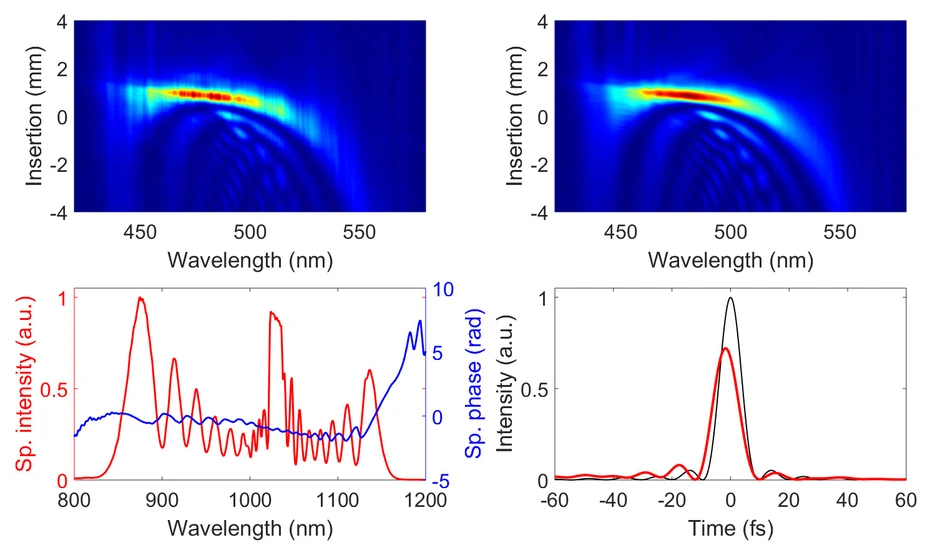Few-cycle pulses break the 300 W barrier
Significant milestone in few-cycle laser technology paving the way towards industrial applications
A team led by researchers from the Max Born Institute for Nonlinear Optics and Short Pulse Spectroscopy (MBI), Laser-Laboratorium Göttingen (LLG) and Active Fiber Systems (AFS) has generated multi-millijoule 3-cycle pulses at 318 W average power level. These results mark a significant milestone in few-cycle laser technology paving the way towards industrial applications. The report appeared in Optica as a Memorandum.
Extreme short light pulses containing only a few oscillations of the electromagnetic field are among the fastest events ever made by mankind. Although the first few-cycle pulses were produced about 30 years ago, they could only be used in cutting-edge science e.g. for time-resolved studies or attosecond pulse generation. In order to find their way into industrial applications, a number of major challenges need to be addressed, such as turn-key operation, and energy and power up-scaling of the few-cycle sources.
The MBI, LLG and AFS scientists followed a novel approach by directly compressing 300 fs long pulses from a high-energy, high-power laser system to the few-cycle duration. This requires a 30-times compression, which has only recently become feasible by the introduction of the stretched flexible hollow fiber technology, which offers unrestricted length scalability. In the study a coherently-combined multi-channel fiber laser delivering up to 10 mJ pulses at up to 1 kW average power was used as the light source. This system is currently under development at AFS for the major European laser facility ELI ALPS in Szeged, Hungary. In the pulse compression, a 6-meter long stretched flexible hollow fiber was used which was developed together by MBI and LLG. As the pulses propagate through argon gas filled into the hollow waveguide, a nonlinear interaction called self-phase modulation takes place between the intense light and the gas atoms which makes the spectrum broaden. The pulses with substantially broadened spectrum can then be compressed to a shorter duration by compensating their spectral phase with a set of chirped mirrors. In this way the team succeeded to generate multi-mJ, 10 fs pulses at 100 kHz repetition rate at an average power of 318 W, which is the highest average power of a few-cycle laser ever achieved.
This achievement shows that using stretched flexible hollow core fiber technology high-power industry-grade lasers can be brought into the few-cycle regime. This opens up new possibilities for industrial applications, such as highly parallelized material processing.
Figure:
Full characterization of the 10 fs NIR pulses by a dispersion scan measurement. Hereby first the spectral phase of the pulses is varied (chirping) by inserting glass with gradually increasing thickness into the beam. Then in a thin nonlinear crystal the second harmonic of the chirped pulses is generated and its spectrum is recorded at the series of different glass insertions. In this way a two-dimensional trace is recorded (shown on the top left panel) from which the missing phase information can be extracted by using an iterative numerical algorithm. The simulated trace given by the phase-retrieval algorithm is shown in the top right panel exhibiting a striking similarity with the measured trace. The measured spectrum of the pulse together with the retrieved phase are shown in the bottom left panel, while their Fourier transform giving the pulse shape (red curve) is displayed bottom right. The black curve in this panel corresponds to the shortest possible pulse for the measured spectrum. (Graphic: MBI)
Publication:
Generation of three-cycle multi-millijoule laser pulses at 318 W average power
T. Nagy, S. Hädrich, P. Simon, A. Blumenstein, N. Walther, R. Klas, J. Buldt, H. Stark, S. Breitkopf, P. Jójárt, I. Seres, Z. Várallyay, T. Eidam, J. Limpert
Optica 6 (2019) 1423-1424, www.osapublishing.org/optica/abstract.cfm
Contact:
Max Born Institute for Nonlinear Optics and Short Pulse Spectroscopy
Dr. Tamás Nagy
Phone 030 6392-1270
Email tamas.nagy(at)mbi-berlin.de
www.mbi-berlin.de
Anja Wirsing
Forschungsverbund Berlin e.V.
Rudower Chaussee 17, 12489 Berlin
Phone 030 6392-3337
Email wirsing(at)fv-berlin.de
www.fv-berlin.de
